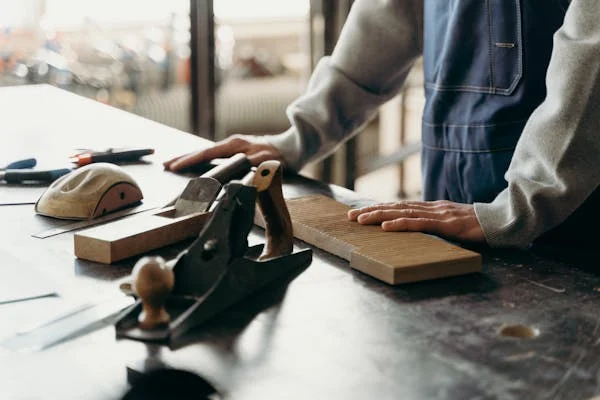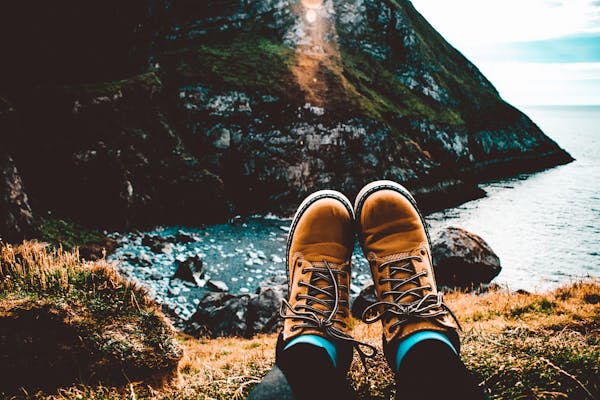What’s the Average Mileage for Hiking Shoes?

Letting go of can be hard especially if you’ve been through many uncertainty together and come through the other side smiling. Sometimes in this hard time, we have to move on. But when certainly is the right time to end such an important relationship between your feet and your beloved hiking boots? Hiking footwear can make or break and success or a failure your hike. Your feet should have worked as the lion’s share of the work, so it’s providing them everything they need to succeed.
Understanding Hiking Shoe Mileage
Factors that Affect Hiking Shoe Lifespan

On average, the quality of hiking boots and trail shoes can go through 500 to 1000 miles ‘805 to 1610 km’. However, the clear-cut mileage depends on factors such as hiker weight, land type, shoe type, and maintenance. Heavyweight and high-mileage hikers will experience quicker wear and tear on their shoes.
Weight and frequency of use
When preparing for outdoor adventures, using the best backpacking weight calculator is an absolute game-changer. It gives you valuable awareness of where your gear weight is concentrated and authorizes you to make planned decisions on reducing weight without sacrificing the essentials.
Terrain and conditions

Such as Hiking is all about exploring diverse landscapes. Each place has its charm and challenges. Sand, rock, or snow – every terrain needs a unique towards to enjoy it fully. You must adjust your steps for various types of ground you step on. Hiking in block-sized rocks requires light, and careful steps to avoid falls. River crossings need to be slow, equable, and even to keep balance. When hiking up steep hills, small quick steps work best. Taking the right gear helps a lot when regulating the terrain while hiking. Have good boots with a strong grip for rocky paths and high tops for sand trails to keep grit out.
Shoe construction and materials

Therefore, Leather uppers. The most customary material for hiking shoe uppers is leather. …
However, Fabric-leather uppers. Many lightweight hiking shoes and boots copy the synthetic-suede design of running shoes.
Synthetic leather uppers
Nylon uppers.
Plastic uppers.
Shoe lining materials.
Boot insole materials
Types of shoe insoles
What’s the Average Mileage for Hiking Shoes?
Average Mileage for Different Hiking Shoe Types

What’s the Average Mileage for Hiking Shoes?
Lightweight/trail running shoes: 300-500 miles
There is no set number of miles you will be getting out of your trail running shoes. Many people think that you need to replace your shoes every 300-500 miles, but this isn’t necessarily the case. The key things to thing about are the wear on the sole of the shoe, and what your legs feel when wearing them
Heavyweight 600 – 1000 miles
Depending upon the construction of the hiking boot, your shoes can last anywhere. As such, it’s necessary to take to the trails with a top-quality pair of boots.
Average Mileage for Hiking Shoes
On average, hiking shoes last between 300-1,000 miles depending on the type and quality. Lightweight hiking or trail running shoes can last 300-500 miles, while heavyweight, durable boots may reach 600-1,000 miles.
Factors Influencing Hiking Shoe Lifespan
- Weight and Frequency of Use
Heavier hikers or frequent use will wear shoes down faster. Rotating pairs can help extend life. - Terrain and Conditions
Rocky or sandy terrains cause more wear, while softer trails are gentler on soles. - Shoe Construction and Materials
Quality materials like leather or synthetic fabrics can impact durability, with leather often lasting longer.
Signs Your Hiking Shoes Need Replacement
- Worn-out Soles: Check for thinning or uneven wear on the treads.
- Loss of Cushioning: If your shoes feel flat or less supportive, they likely need replacing.
- Reduced Support: Noticeable discomfort or lack of stability during hikes signals wear on structural support.
Tips to Extend Hiking Shoe Lifespan
- Regular Cleaning: Rinse after each hike and dry thoroughly at room temperature.
- Rotate Pairs: Alternate shoes to prevent rapid wear and allow shoes to recover.
- Replace Insoles: Worn insoles can be swapped to restore comfort and support.
Resoling and Repairs
For significant damage like a punctured sole, find a reputable repair service for resolving to extend boot life.
Signs Your Hiking Shoes Need Replacing
Excessive wear on the soles

If you notice that the inner edge of your shoe is wearing out faster than normal, it means your feet are protracted excessively. Foot pronation means your foot arch falls in during walking which leads to your ankle rolling inwards when you walk. People whose feet pronate experience very little or no shock absorption as they walk
Loss of cushioning and support
What’s the Average Mileage for Hiking Shoes?
In addition, Shoes that lack proper shields and support can lead to heel pain and exhausted achy feet at the end of the day. After some time, serious complications may arise.
Extending the Life of Your Hiking Shoes
Proper Hiking Shoe Care

Cleaning and drying after each use
Furthermore, Rinse your hiking shoes with water. If necessary, use a soft brush or awash to remove any mud and dirt that’s left. It’s necessary to allow your shoes to dry completely after you wash them! Let them dry at room temperature in a breezy area.
Rotating between multiple pairs
Do you know the benefits of having multiple pairs of shoes in your shoe swiftly, particularly if you’re running on working and consecutive days, are involved in particular running workouts, or like to Differ your fitness program by sometimes trading the road for the trail? From reducing your injury risk to renovating your workouts, having a variation of shoes on offer can help you keep on track of your training while keeping your footgear in top shape for a long
Replacing worn insoles

When to Resole or Resole Hiking Shoes
On the other hand, if your hiking boots have sustained more significant damage, such as a torn or punctured sole, a broken shank, or damage to the upper, you may want to consider having them repaired.
Indicators that resoling is needed
Sometimes it’s evident- if the soles of your boots are coming loose, or have holes in them, those are evident signs that the soles are shabby out and need to be replaced. Other times it’s less obvious. Even if the soles look OK, it’s possible the sole has been worn thin, providing less traction and shock absorbency
Finding a reputable shoe repair service

Must-Know Tips for Choosing a Reliable and Good Shoe Repair Shop
Peruse Online for Shoe Repair Shops Near Me. …
Ask for Referrals from Friends and Family. …
Check Out the Store in Person. …
Ask About Services Offered and Materials Used. …
Inquire About Turnaround Time and Pricing. …
Read Customer Reviews and Testimonials.
FAQs on Hiking Shoe Mileage and Care
1. How many miles can I expect my hiking shoes to last?
Hiking shoes typically last 300-1,000 miles depending on type, materials, and usage frequency.
2. What type of hiking shoes last the longest?
Heavyweight hiking boots, often made with durable leather, generally last longer (600-1,000 miles) than lightweight trail shoes (300-500 miles).
3. How can I tell if my hiking shoes need replacing?
Signs include worn-out soles, loss of cushioning, reduced support, and discomfort or pain during hikes.
4. Does terrain affect the lifespan of hiking shoes?
Yes, rough or rocky terrains wear down shoes faster, while softer, flat trails are gentler on soles.
5. Can I extend the life of my hiking shoes?
Yes, clean and dry shoes after every hike, rotate pairs, and replace insoles as needed to keep them in good condition.
6. Is it worth resoling hiking boots?
For high-quality, durable boots, resoling can extend their life; however, lightweight shoes are often less cost-effective to resole.
7. What’s the best way to dry my hiking shoes?
Remove the insoles and air-dry shoes at room temperature in a well-ventilated area. Avoid direct heat, which can damage materials.
Difference Table: Hiking Shoes vs. Hiking Boots
| Feature | Hiking Shoes | Hiking Boots |
| Mileage | 300-500 miles | 500-800 miles |
| Weight | Lightweight | Heavier |
| Terrain Suitability | Moderate trails |
Rugged and steep trails
|
| Ankle Support | Minimal | High |
| Break-In Time | Short | Longer |
Conclusion
In conclusion, Normally speaking, the average shelf life of a quality hiking boot ranges from 600 to 1,000 miles. In other terms, if the standard hiker scales violently 8 miles a day, her boots will last a little over 4 months, provided the trail and ground remain the same and proper drying of the fabric after each trip and wash. The best way to dry them is to take the sole out and let it dry in the sunlight during summers and use home boot dryers to dry them during winters. Regularly cleaning dirt and mud from shoes after each trip. Dirt and mud will eat away the fibers and cheapen them even quicker, resulting in a reduction in the imperishability of the boots.
.


[…] Hiking the Appalachian Trail: A Guide to Meal Planning.The vision of luxuriant forests, gabble brooks, and rough mountains gesture to outdoor fanatics from different parts of the earth. Carry lots of snacks, including things you can stow in your pockets and nibble while you are hiking. You’ll have more energy if you snack often compared to if you eat only big meals. Energy bars or a mix of dried fruit, nuts, and chocolate bits work well. Furthermore, The one peculiarity abnormality to my no-stove lifestyle would be if I were hiking in temperatures where melting ice was essential to create water. […]
[…] the sticks are used with the accurate technique extremely. Therefore, when walking downward the hiking stick can absorb various tonnes of […]
[…] break your heart and not in the way you might anticipate. This transformative experience brings emotional challenges that can be just as demanding as the long hauls you’ll […]
[…] fanatics from all over the world. Surrounded by a lot of trails that journey over this beautiful countryside, the Appalachian Trail stands out as the highest level for hikers. However, even the most […]